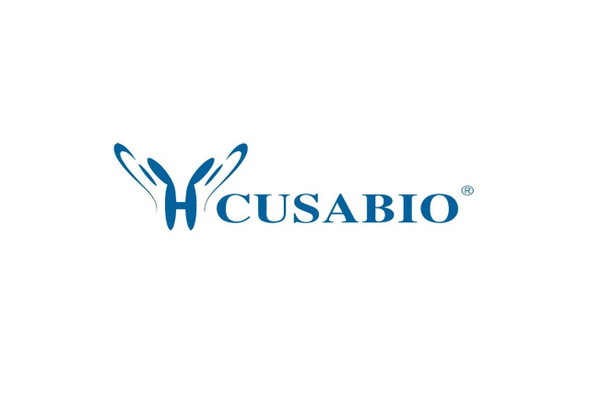Cusabio Human Recombinants
Recombinant Human Unconventional myosin-VIIa (MYO7A), partial | CSB-EP622657HU
- SKU:
- CSB-EP622657HU
- Availability:
- 13 - 23 Working Days
Description
Recombinant Human Unconventional myosin-VIIa (MYO7A), partial | CSB-EP622657HU | Cusabio
Alternative Name(s): MYO7A; USH1B; Unconventional myosin-VIIa
Gene Names: MYO7A
Research Areas: Signal Transduction
Organism: Homo sapiens (Human)
AA Sequence: WAVLTVQAYARGMIARRLHQRLRAEYLWRLEAEKMRLAEEEKLRKEMSAKKAKEEAERKHQERLAQLAREDAERELKEKEAARRKKELLEQMERARHEPVNHSDMVDKMFGFLGTSGGLPGQEGQAPSGFE
Source: E.coli
Tag Info: N-terminal 6xHis-SUMO-tagged
Expression Region: 838-968aa
Sequence Info: Partial
MW: 31.3 kDa
Purity: Greater than 90% as determined by SDS-PAGE.
Relevance: Myosins are actin-based motor molecules with ATPase activity. Unconventional myosins serve in intracellular movements. Their highly divergent tails bind to membranous compartments, which are then moved relative to actin filaments. In the retina, plays an important role in the renewal of the outer photoreceptor disks. Plays an important role in the distribution and migration of retinal pigment epithelial (RPE) melanosomes and phagosomes, and in the regulation of opsin transport in retinal photoreceptors. In the inner ear, plays an important role in differentiation, morphogenesis and organization of cochlear hair cell bundles. Involved in hair-cell vesicle trafficking of aminoglycosides, which are known to induce ototoxicity (By similarity). Motor protein that is a part of the functional network formed by USH1C, USH1G, CDH23 and MYO7A that mediates mechanotransduction in cochlear hair cells. Required for normal hearing.
Reference: "The Usher 1B protein, MYO7A, is required for normal localization and function of the visual retinoid cycle enzyme, RPE65."Lopes V.S., Gibbs D., Libby R.T., Aleman T.S., Welch D.L., Lillo C., Jacobson S.G., Radu R.A., Steel K.P., Williams D.S.Hum. Mol. Genet. 20:2560-2570(2011).
Storage: The shelf life is related to many factors, storage state, buffer ingredients, storage temperature and the stability of the protein itself. Generally, the shelf life of liquid form is 6 months at -20?/-80?. The shelf life of lyophilized form is 12 months at -20?/-80?.
Notes: Repeated freezing and thawing is not recommended. Store working aliquots at 4? for up to one week.
Function: Myosins are actin-based motor molecules with ATPase activity. Unconventional myosins serve in intracellular movements. Their highly divergent tails bind to membranous compartments, which are then moved relative to actin filaments. In the retina, plays an important role in the renewal of the outer photoreceptor disks. Plays an important role in the distribution and migration of retinal pigment epithelial (RPE) melanosomes and phagosomes, and in the regulation of opsin transport in retinal photoreceptors. In the inner ear, plays an important role in differentiation, morphogenesis and organization of cochlear hair cell bundles. Involved in hair-cell vesicle trafficking of aminoglycosides, which are known to induce ototoxicity (By similarity). Motor protein that is a part of the functional network formed by USH1C, USH1G, CDH23 and MYO7A that mediates mechanotransduction in cochlear hair cells. Required for normal hearing.
Involvement in disease: Usher syndrome 1B (USH1B); Deafness, autosomal recessive, 2 (DFNB2); Deafness, autosomal dominant, 11 (DFNA11)
Subcellular Location: Cytoplasm, Cytoplasm, cell cortex, Cytoplasm, cytoskeleton
Protein Families: TRAFAC class myosin-kinesin ATPase superfamily, Myosin family
Tissue Specificity: Expressed in the pigment epithelium and the photoreceptor cells of the retina. Also found in kidney, liver, testis, cochlea, lymphocytes. Not expressed in brain.
Paythway:
Form: Liquid or Lyophilized powder
Buffer: If the delivery form is liquid, the default storage buffer is Tris/PBS-based buffer, 5%-50% glycerol. If the delivery form is lyophilized powder, the buffer before lyophilization is Tris/PBS-based buffer, 6% Trehalose, pH 8.0.
Reconstitution: We recommend that this vial be briefly centrifuged prior to opening to bring the contents to the bottom. Please reconstitute protein in deionized sterile water to a concentration of 0.1-1.0 mg/mL.We recommend to add 5-50% of glycerol (final concentration) and aliquot for long-term storage at -20?/-80?. Our default final concentration of glycerol is 50%. Customers could use it as reference.
Uniprot ID: Q13402
HGNC Database Link: HGNC
UniGene Database Link: UniGene
KEGG Database Link: KEGG
STRING Database Link: STRING
OMIM Database Link: OMIM










